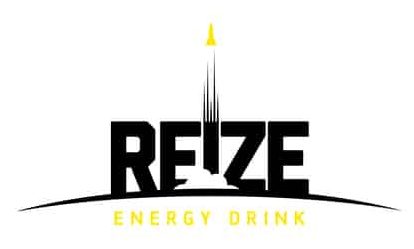Advertised under the Mountain Dew brand, AMP Energy Drink is pretty much your classic energy drink, featuring sugar, caffeine, and a whole host of other ingredients to provide you with the energy boost you need.
If you’ve found yourself here, you’re probably curious about the content of AMP Energy Drink, and if the ingredients present do contribute to the overall drink.
For a brief overview, a 16 fl. oz can of AMP Energy has 220 calories, 58g of sugar, and 142mg of caffeine, along with other nutrients such as B-Vitamins, and additives which include ginseng and guarana extracts.
For a more detailed look at the caffeine and ingredients of AMP Energy Drinks and what each of them does, read on to find out.
AMP Energy Nutrition Facts
Here’s a quick look at the nutritional value of AMP Energy to give you an overview of what you get out of a can:
| Value (Standard Serving) | AMP Energy (16 fl. oz) |
| Energy | 220 calories |
| Protein | 0g |
| Carbohydrates (Of which Sugars) | 58g (58g) |
| Sodium | 140mg |
| Caffeine | 142mg |
| Vitamin B2 (Riboflavin) | 0.7mg |
| Vitamin B3 (Niacin) | 4mg |
| Vitamin B5 (Pantothenic Acid) | 2mg |
| Vitamin B6 | 0.3mg |
| Vitamin B12 | 1.2μg |
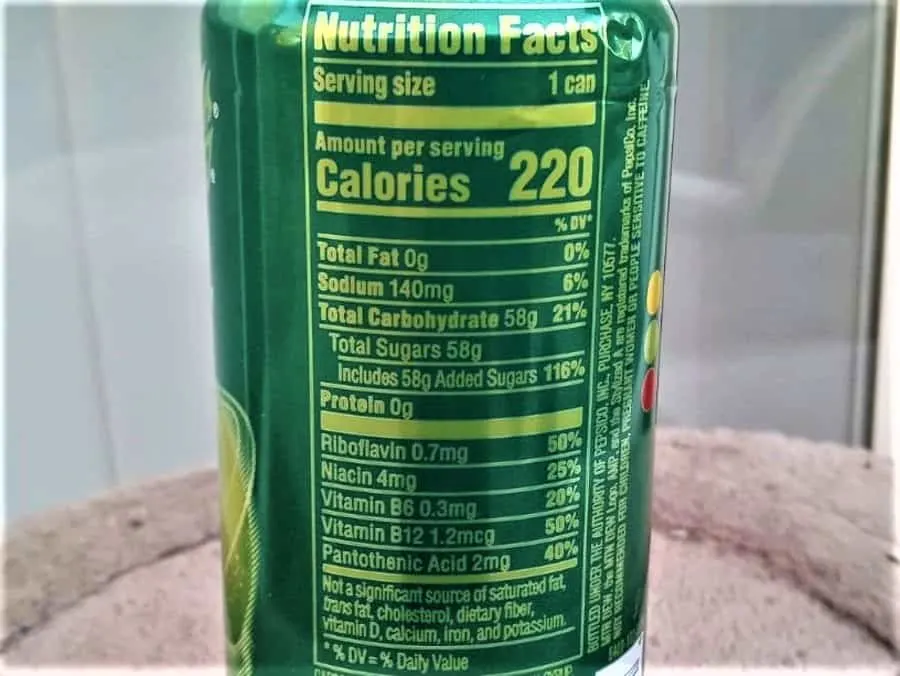
How Many Calories Are In An AMP Energy Drink?
A regular can of AMP Energy has 220 calories per 16 fl. oz, which makes the drink pretty calorie-heavy, and certainly not suited for you if you’re on a diet.
For reference, AMP has a similar amount of calories to a 16 fl. oz can of Monster (210 calories), making it one of the higher-calorie energy drinks you can find off a shelf.
Given that you only really need around 2,000 to 2,500 calories per day (dependent on how active you are and biological factors), a single can of AMP already takes up to 1/10th of your daily caloric intake.
So if you happen to be on a diet or are watching your calorie intake closely, you might want to skip this particular energy drink, not to mention that a can of AMP may put a dent in your appetite as well.
That being said, AMP Energy does provide you with a substantial amount of calories, so if you need to get yourself out of a low-sugar funk, then a can of AMP will certainly work wonders.
Fair warning, while AMP does have a decent amount of calories, they’re not going to work as a complete replacement for an actual meal due to the difference in nutritional content.
All-in-all, have an AMP when you think you need a quick, no-fuss boost, and try not to have it too often or use them as a substitute for actual meals, as they don’t work nearly as well as you think.
If you’re not too fond of the whole calorie thing, take a look at the article I’ve written on the best zero-calorie energy drinks, where I’ve listed some great alternatives for you to try out.
AMP Energy Ingredients
A list of all the ingredients that go into AMP Energy, with a more detailed analysis of them further below:
- Carbonated Water
- High Fructose Corn Syrup
- Citric Acid
- Concentrated Orange Juice
- Natural Flavors
- Sodium Benzoate (Preserves Freshness)
- Sodium Polyphosphates (To Protect Flavor)
- Caffeine (142mg)
- Guarana Seed Extract
- Gum Arabic
- Niacinamide (Vitamin B3)
- Ascorbic Acid (To Protect Flavor)
- Taurine
- Calcium Disodium EDTA (To Protect Flavor)
- Riboflavin
- Calcium Pantothenate (Vitamin B5)
- Panax Ginseng Root Extract
- Pyridoxine Hydrochloride (Vitamin B5)
- Cyanocobalamin (Vitamin B12)
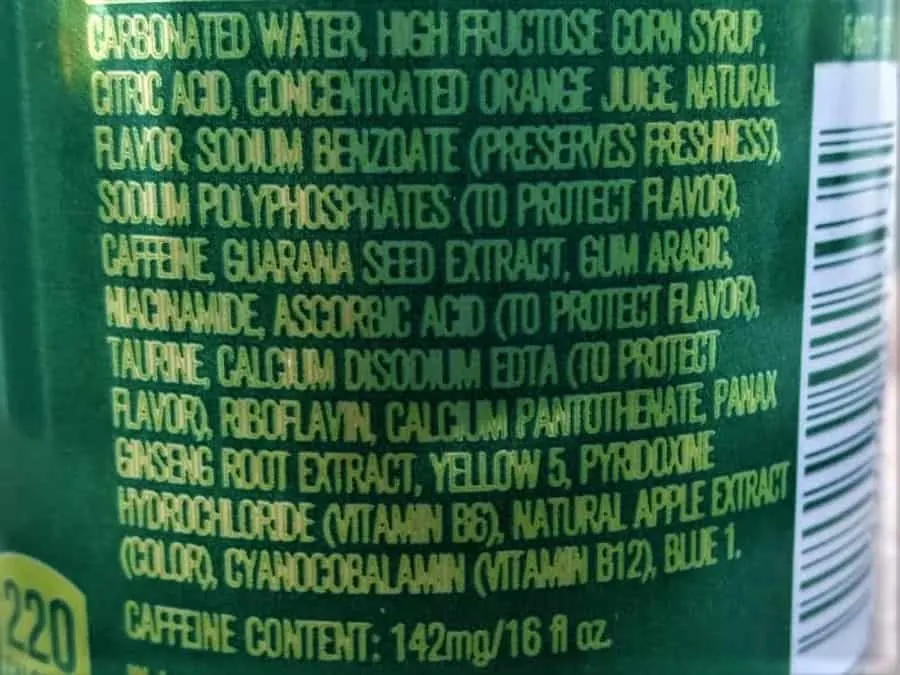
AMP Energy Drinks Ingredients Analysis
High Fructose Corn Syrup
High-Fructose Corn Syrup (HFCS) is an artificial sugar derived from corn, and, like any other sugar, it’s pretty bad for you if you consume it consistently for an extended period of time.
Though correlation doesn’t necessarily equal causation, HFCS has been linked to the increase of obesity over the past decade due to how affordable it is compared to regular sugar.
Of course, there’s no harm in having products with HFCS on some occasion, but having too much of it, whether knowingly or not, has multiple downsides, such as:
- fatty liver disease
- obesity
- weight gain
- diabetes
So while a single can of AMP Energy won’t instantly wreck your health, consistently having food products with HFCS present is a bad idea, so do be aware of how much HFCS you’re consuming at any given time.
Citric Acid
Citric Acid is a weak organic acid found in citrus fruits, such as lemon, lime, and oranges.
While citric acid is found quite abundantly in nature, the citric acid found in energy drinks is generally from a synthetic source, as it’s a much cheaper alternative than harvesting it.
Aside from its sour taste (bite a lemon, I dare you), citric acid is mainly used as a preservative and to adjust the pH of the drink, which doesn’t make it too interesting of an ingredient.
Concentrated Orange Juice
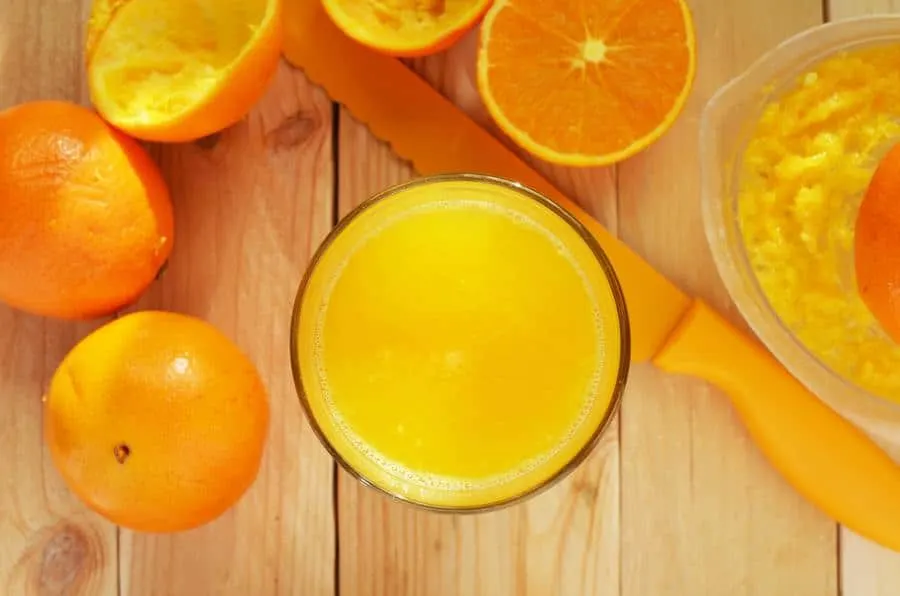
This ingredient is essentially orange juice with most of its water content removed, which leaves a very sour concoction.
While it may seem like a healthy thing, juice concentrates are deprived of many things that make fruit juice what it is, such as fiber and natural sugars from fruits.
That being said, AMP Energy already has a pretty high amount of sugar for an energy drink, so we can assume that the concentrate is used mainly for flavoring and pH-balancing purposes instead of anything substantial.
Guarana Seed Extract
Originating from Brazil, guarana boasts an impressive range of both stimulants and antioxidants for your immediate benefit.
Guarana is most commonly known for its ability to reduce fatigue and improve focus, which isn’t too surprising when you consider that a large portion of guarana consists of caffeine.
Considering AMP already has a decent amount of caffeine present, it’s hard to discern if you’re actually getting any benefits from guarana, so do take this ingredient with a grain of salt.
Gum Arabic
Sourced from the acacia tree, Acacia Gum is used in multiple products and acts as a source of dietary fiber in drinks (although not to an effective amount in AMP).
While mainly used as an emulsifying and stabilizing agent for drinks, gum Arabic also tends to make you feel fuller than you actually are, helping to reduce overall caloric intake.
Of course, there’s no telling how much gum arabic is present in AMP unless I do a lab test, but I wager that the gum arabic present acts more as a stabilizing agent than a source of fiber in AMP.
Taurine
Taurine is an amino acid that comes with a variety of potential benefits, being a common ingredient in energy drinks.
Although it’s been greatly associated with Red Bull, taurine is an ingredient you can find in a lot of other energy drinks as well, from Rockstar to REIZE and everything in between.
As for the benefits of taurine, some of the more prominent ones include helping nerve growth and also reducing blood pressure.
While taurine has also been claimed to improve cognitive performance, research suggests that caffeine plays the same role as taurine in that aspect when it comes to energy drinks.
As such, it’s hard to tell how much benefit you’re getting from taurine, but there’s no harm in having it in your drink, so there’s no need to worry too much about it.
Panax Ginseng Root Extract
Ginseng is a herb that’s often used in traditional remedies and cuisines, being a common ingredient in energy drinks as well, as being present in GURU, REIZE, and AMP.
Aromatic and with a unique earthly flavor, suitable doses of ginseng may bring notable benefits such as reducing blood sugar, increased energy levels, and anti-inflammatory effects.
How Much Caffeine Does AMP Energy Drink Have?
A regular 16 fl. oz can of AMP Energy has 142mg of caffeine, which is fairly typical for an energy drink of its size.
Caffeine and energy drinks go hand-in-hand, being the main ingredient that drives an energy drink’s ability to keep you awake, improve your reaction times as well as assist in overall cognitive function.
142mg of caffeine is actually pretty average for an energy drink. For comparison, a 16 fl. oz can of Rockstar and Monster have 160mg each, which isn’t that much more than a can of AMP.
While AMP isn’t a strong energy drink, it still has some kick to it, which may hit you hard, especially if you’re more sensitive to caffeine.
Personally, I prefer my energy drinks to have between 50 to 100mg of caffeine per serving. So while AMP is slightly higher than my usual, I wouldn’t mind a can of it if I happen to be craving a sugar rush.
That said, depending on your caffeine metabolism and overall lifestyle, the energy boost that you get from AMP will vary. Hence, my advice is to know your limits first before having AMP.
Just be sure to keep your caffeine consumption within a reasonable amount, or whatever happens to be your personal limit.
For guidance, the FDA approves a caffeine intake limit of no more than 400mg per day. Any more than that might lead to some unpleasant side effects such as anxiety, restlessness, headaches, and so on.
So be sure not to have too many cans of AMP in a single day, and try to keep your overall caffeine intake at a tolerable minimum.
How Much Sugar Is In AMP Energy Drink?
Each 16 fl. oz can of AMP Energy Drink has 58g of sugar, which is a pretty high amount for an energy drink of this size.
Given that the AHA recommends a daily sugar limit of no more than 25g for women and 36g for men, a single can of AMP Energy has way more sugar than what you should be having daily.
While it’s fine to indulge in some sugary goodness occasionally, consistently having too much sugar can lead to some pretty bad health problems, such as:
- Weight Gain
- Type II Diabetes
- Increased risk of heart disease
- Acne
- Increased risk of depression
Apart from that, you’re also a lot more liable to suffer from a sugar crash due to the spike and fall in blood sugar, especially after you feel the effects of the caffeine wear off.
Although a can of AMP might perk you up after a long day’s work, it’s probably best to keep the consumption to a minimum, especially since the ramifications of a high-sugar diet are pretty well-known.
If you don’t feel like dealing with all that sugar, take a look at the article I’ve written on the best energy drinks with less sugar for some great energy drinks that are a lot better for your health.
B-Vitamins in AMP Energy Drink
B-Vitamins are common nutritional additives in any energy drink, so it’s not surprising that it’s present in AMP as well.
Here are the B vitamins found in AMP Energy:
- Vitamin B2
- Vitamin B3
- Vitamin B5
- Vitamin B6
- Vitamin B12
While not a substantial amount, the B-Vitamin content is pretty nice, although it’s probably not the most optimal way to add a decent amount of B-Vitamins into your diet.
If you would like to know more about them and how exactly they can benefit you, click here to read a helpful Harvard resource.
Is AMP Energy Bad For You?
So long as you’re healthy and know how to keep your caffeine and sugar intake in check, you should be fine with having a can of AMP Energy occasionally.
While having an AMP on occasion won’t be too detrimental to your health, you might want a lower-calorie alternative if you decide you want energy drinks to be your daily source of caffeine.
The problem with having AMP daily is that it adds an excessive amount of sugar to your diet, and with all that sugar, it inevitably comes with calories as well.
So reserve AMP for the occasions when you really need to keep your blood sugar at a certain level, or for when you need a quick burst of energy to finish off the final leg of a job.
AMP Energy Drink VS Game Fuel
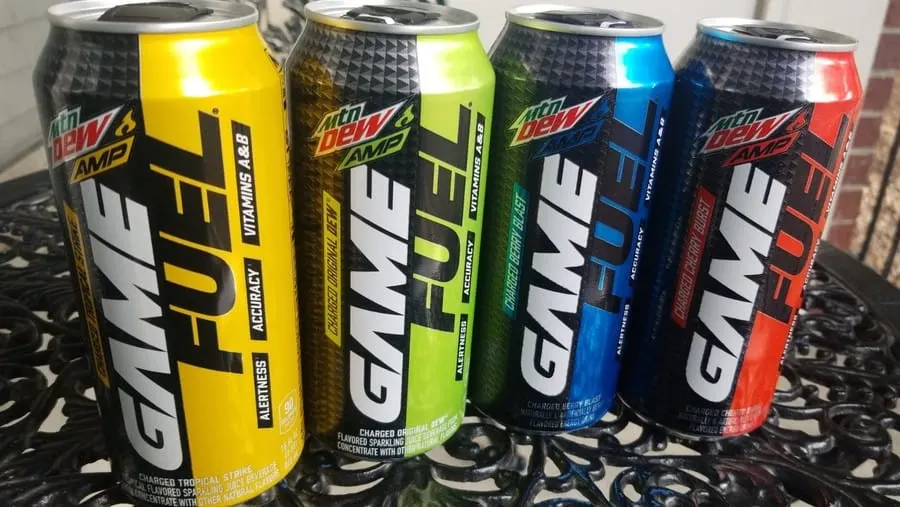
| AMP Energy (16 fl. oz) | Game Fuel (16 fl. oz) | |
| Calories | 228 calories | 90 calories |
| Caffeine | 160mg | 159mg |
| Sugar | 51g | 23g |
From a health perspective, Game Fuel is definitely a lot healthier than AMP Energy, having a lower amount of sugar and calories. But, they’re equal in terms of the amount of caffeine.
Although they’re from the same manufacturer, Game Fuel, and AMP are two very different energy drinks, with Game Fuel definitely being the healthier, less sugar-rush-inducing option of the two.
Of course, for a pure short-term energy boost, AMP Energy is definitely the better choice, but if you want an energy drink that can give you a consistent boost and can have it daily, then you can’t go wrong with Game Fuel.
For more information on Game Fuel and how it differs from AMP Energy, have a look at the article I’ve written in detail about the ingredients and caffeine of Game Fuel.
AMP Energy Drink Flavors
With only 4 flavors, AMP has a rather small pool of fruity options for you to choose from. So if you’re looking for something fresh and exciting, you’re a bit out of luck.
Here are the four flavors of AMP Energy Drink:
- Original Dew
- Tropical Punch
- Strawberry Limeade
- Cherry Blast
AMP Energy Drink Alternatives
While AMP may not be the energy drink for you, here are some other options that might fit the bill:
- Celsius
- Bang
- Reign
- Rockstar
- Adrenaline Shoc
- C4 Energy
- G Fuel Cans
- Game Fuel
- Red Bull
- 5 Hour Energy
- Raze Energy
- Monster
- Uptime Energy
- Xyience
- 3D Energy
- Raze Energy
- C4 Energy
There are also some awesome powdered energy drinks as well if you prefer to have the flexibility of personalizing your own energy drink servings:
- Advocare Spark
- G Fuel
- Zipfizz
- REIZE (my fav)
Final Verdict
AMP Energy Drink, just like any other energy drink, does its job of waking you up and giving you a quick boost of energy. One 16 fl. oz. can of AMP contains 142 mg of caffeine, 58 g of sugar, and 220 calories.
While the caffeine content of AMP is pretty standard for an energy drink, the sugar content is pretty alarming. Not only does it go beyond the AHA’s recommended sugar intake for men and women, but it also carries a ton of calories. This isn’t ideal if you’re looking for an energy drink to pair with your diet.
Overall, besides its sugar content, AMP isn’t all that bad. It’s a pretty good drink to have when you’re feeling low or tired but I wouldn’t go so far as to say it’s a good drink to have for a workout or a diet. It also isn’t ideal to have this drink daily.
REIZE (10 out of 10)
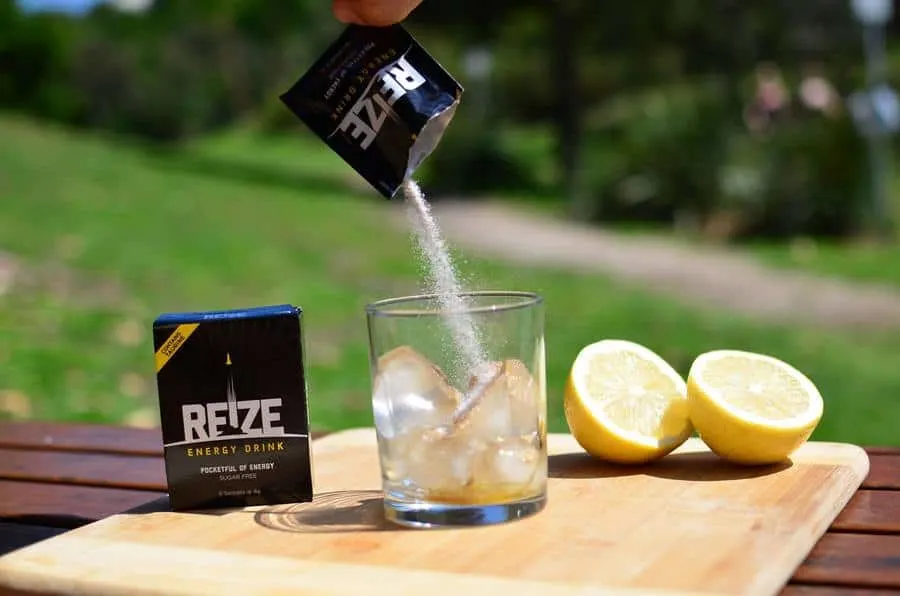
Want an energy drink that can give you a good boost without all the extra sugar and calories? REIZE is definitely the energy drink for you.
REIZE is a brilliant powdered energy drink that comes in convenient 4g sachets. With a sensible 50mg of caffeine, it’s completely sugar-free and has only 11 calories per serving.
REIZE also contains a smart blend of taurine, ginseng, and B-group vitamins, all of which combine to give you the perfect energy boost without the sugar crash afterwards.
Best of all, REIZE ships straight to your door for only about $1 per drink, which is pretty great value for money.
So try out REIZE today, and I’m sure you’ll find it to be a smarter option than AMP Energy.
